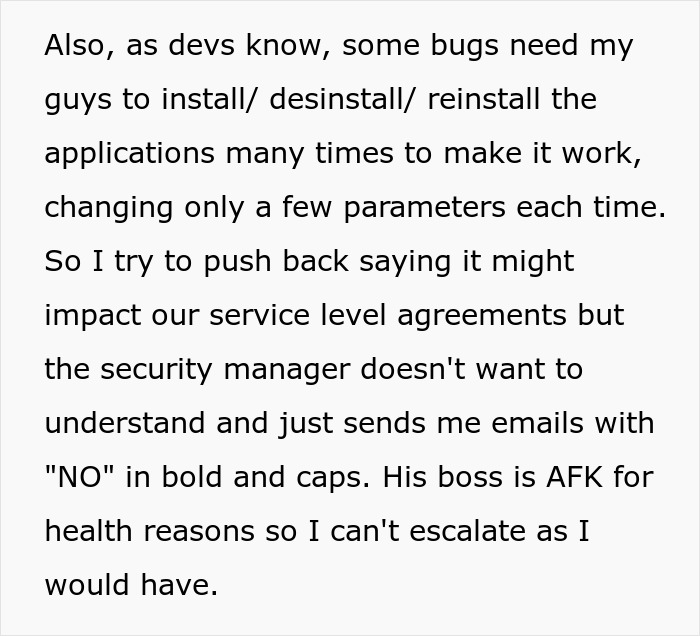It’s very frustrating when someone at work who’s clueless about your job starts reorganizing it just because they can. And it’s even worse when they dismiss your concerns about the changes they’re making.
When Reddit user and software development team manager Available-Election86 heard that their security guy wants to revoke their entire team’s computer administrator rights, they did everything in their power to stop it.
However, the man didn’t change his mind. So Available-Election86 resorted to the last option — malicious compliance.
This software development team manager was shocked to hear that his staff are losing their computer administrator rights

Image credits: Procreator UX Design Studio (not the actual photo)
But as soon as the staff started complying with the new policy, things at work quickly got out of hand








Image credits: bruce mars (not the actual photo)








Image credits: u/Available-Election86
The company’s (former) security manager was very wrong to completely dismiss everything Available-Election86 said. When Harold “Hal” L. Sirkin, Perry Keenan, and Alan Jackson studied change initiatives at 225 companies, they found a consistent correlation between the outcomes (success or failure) and four hard factors and four hard factors, which they called DICE: project duration, particularly the time between project reviews; integrity of the performance, or the capabilities of project teams; the level of commitment of senior executives and staff; and the additional effort required of employees directly affected by the change.
“If you think about it, the different ways in which organizations combine the four factors create a continuum—from projects that are set up to succeed to those that are set up to fail, Sirkin, Keenan, and Jackson wrote in Harvard Business Review.
“At one extreme, a short project led by a skilled, motivated, and cohesive team, championed by top management and implemented in a department that is receptive to the change and has to put in very little additional effort, is bound to succeed.”
“At the other extreme, a long, drawn-out project executed by an inexpert, unenthusiastic, and disjointed team, without any top-level sponsors and targeted at a function that dislikes the change and has to do a lot of extra work, will fail,” the researchers explained.
Which is exactly what happened with at our Redditor’s company.

Image credits: Ant Rozetsky (not the actual photo)
“Companies must boost the commitment of two different groups of people if they want change projects to take root: they must get visible backing from the most influential executives, who are not necessarily those with the top titles, and they must take into account the enthusiasm—or often, lack thereof—of the people who must deal with the new systems, processes, or ways of working,” Sirkin, Keenan, and Jackson highlighted.
When managers launch transformation efforts, they often don’t realize, or know how to deal with the fact, that employees are already busy with their day-to-day responsibilities.
Because of that managers must calculate how much work employees will have to do beyond their existing responsibilities to change over to new processes. “Ideally, no one’s workload should increase more than 10%. Go beyond that, and the initiative will probably run into trouble,” the researchers said. “Resources will become overstretched and compromise either the change program or normal operations. Employee morale will fall, and conflict may arise between teams and line staff.”
The least Available-Election86’s (former) security manager could’ve done after he went ahead with the new policy was to take away some of the regular work of employees who were affected by the change. Instead, he refused to acknowledge his mistake even when it was growing in front of him.
A lot of people related to the original poster (OP) by sharing their own similar stories






And everyone applauded their nonchalant reaction to this ridiculous demand










 Follow Us
Follow Us





